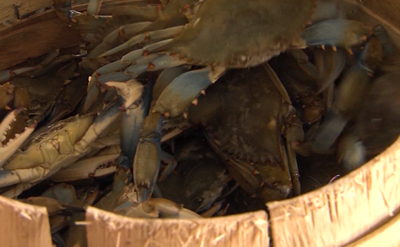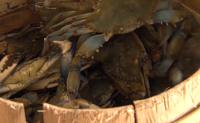CHESAPEAKE BAY - The Virginia Marine Resources Commission (VMRC) has voted 5-4 to repeal a ban on blue crab dredging in the winter near the mouth of the Chesapeake Bay, drawing criticism from Maryland.
According to Maryland’s Department of Natural Resources (DNR), Virginia’s blue crab dredge fishery has been closed for almost 15 years in a cooperative effort with Maryland to maintain healthy populations of blue crabs in the Chesapeake. On June 25th, the VMRC voted to end that closure, a move that Maryland officials say is a mistake and threatens to reverse blue crab population recovery efforts.
However, this vote does not make this a done deal. As a result, the VMRC will discuss and explore the possibility of opening a year round crab fishery.
In a statement VMRC says, "The repeal of the crab dredge prohibition does not open a crab dredge fishery in Virginia. This vote by the Commission allows VMRC staff to explore the viability of a year-round crab fishery that may serve to bolster the commercial crabbing industry during times of the year where jobs are often lost during industry closures, losing access to workers and customers. This includes understanding how a limited fishery could operate sustainably without compromising overall crab stocks."
DNR says winter dredging would target mostly female blue crabs at a critical life cycle stage. VMRC staff presented findings to the Commission estimating the harvest of 32% of female crabs in the Bay at the beginning of the dredge season and up to 96% of the dredge harvest being female blue crabs.
Virginia and Maryland’s joint management approach limiting the harvest of female crabs resulted in the recovery of blue crab populations following 10 years of low abundance in the 1990s and 2000s, according to DNR.
“The Virginia Commission’s unilateral decision will impact the species at a time when Marylanders are regularly sitting down to pick crabs with their friends and families,” DNR Secretary Josh Kurtz said in a statement following VMRC’s vote Tuesday. “A decision of this magnitude should have only been made with the support of scientists, in close consultation with Maryland officials, and in response to a significant increase in the blue crab population. It’s a bad day if you care about blue crabs. We are reviewing our options to ensure the sustainability of the blue crab fishery.”
The Chesapeake Bay Foundation (CBF) joined Maryland officials in voicing their disapproval of Virginia’s decision.
“The Virginia Marine Resources Commission’s decision to reopen the winter crab season this year puts the prospect of a healthy blue crab population in the Chesapeake Bay in jeopardy,” CBF Virginia Executive Director Chirs Moore said. “It is incredibly disappointing. The VMRC’s vote imperils not only the vulnerable blue crab, but the sustainability of harvests throughout the year and other species in the Bay that depend on the blue crab for food.”
In an interview with WBOC Moore added that if the VMRV approves year-round crab dredging, it could ruin the work they have done to protect the population. He says it's because 95% of the dredged crabs in the winter would be females. "By harvesting these females, over the winter before many of the them actually have the chance to release their eggs for the first time could up end some of the positives we've had for the population for the past 10 to 12 years," says Moore.
Crabber and president of the Dorchester Watermen Association Bobby Whaples has similar concerns. But he also asks what could happen to the bushel limits?
Whaples says, "They do a bay wide dredge survey which is in Maryland and Virginia so it could effect our bushel limits. We have female bushel limits now and we have male bushel limits a couple months a year. So, all of that could change how many bushels we're allowed to catch. It's not a good thing for Maryland crabbers but I'm sure the Virginia crabbers are happy."
VMRC is expected to establish the parameters of the reopened winter dredge season in September, according to CBF.
Key Points from VMRC’s Decision
Understanding the Historical Context
- 2008 Data and Impact: In 2008, there were 98 crab dredge licenses issued, resulting in the harvest of approximately 1.4 million pounds of crabs during the winter dredge season. This accounted for roughly 17% of the total annual harvest.
- Current Participation: Projections indicate that, if reopened, no more than 20 crabbers are expected to have interest in obtaining a dredge license. This translates to a minimal increase in overall crab harvest.
- Potential Harvest Impact: Of those potentially licensed, estimates are around 15 active participants, an estimated 0.75% increase in harvest could result from a winter dredge fishery, based on recent numbers. This calculation considers a modest effort spread over January and February.
Evaluating the Potential for a Sustainable Year-Round Crab Fishery
- Staff Assessment: VMRC staff now have the capacity to accurately evaluate the potential for a year-round crab fishery and its integration with current management strategies. This includes understanding how a limited fishery could operate sustainably without compromising overall crab stocks.
- Collaborative Efforts: Staff will continue to collaborate with the Crab Management Advisory Committee (CMAC) and the Virginia Institute of Marine Science (VIMS) to assess the feasibility and impacts of a year-round crab fishery. Findings from this evaluation will be presented to the Commission in September.
Addressing Regulatory and Economic Considerations
- Regulatory Alignment: The repeal of the prohibition allows for the development of a regulatory framework that aligns with contemporary management practices. This approach seeks to address the regulatory burden on the user group by integrating the fishery into existing crab management guidelines.
- Economic Viability: Reintroducing the fishery under a controlled and regulated framework could offer an opportunity to revitalize local economies by providing employment and boosting state revenues through a renewed and sustainable year-round crab fishery.
The VMRC's decision to repeal the winter crab dredging prohibition is a significant step towards exploring the viability of a well-regulated year-round crab fishery. The staff's ongoing evaluation, in conjunction with CMAC and VIMS, aims to ensure that any future fishery operates sustainably within the broader context of crab management efforts.



